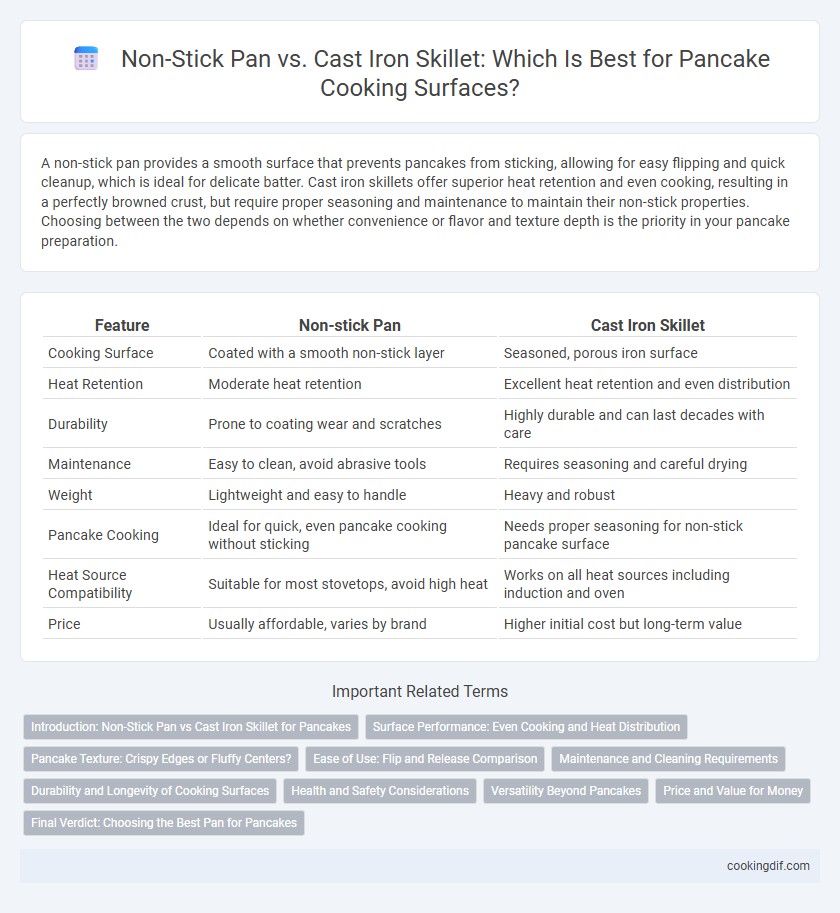A non-stick pan provides a smooth surface that prevents pancakes from sticking, allowing for easy flipping and quick cleanup, which is ideal for delicate batter. Cast iron skillets offer superior heat retention and even cooking, resulting in a perfectly browned crust, but require proper seasoning and maintenance to maintain their non-stick properties. Choosing between the two depends on whether convenience or flavor and texture depth is the priority in your pancake preparation.
Table of Comparison
| Feature | Non-stick Pan | Cast Iron Skillet |
|---|---|---|
| Cooking Surface | Coated with a smooth non-stick layer | Seasoned, porous iron surface |
| Heat Retention | Moderate heat retention | Excellent heat retention and even distribution |
| Durability | Prone to coating wear and scratches | Highly durable and can last decades with care |
| Maintenance | Easy to clean, avoid abrasive tools | Requires seasoning and careful drying |
| Weight | Lightweight and easy to handle | Heavy and robust |
| Pancake Cooking | Ideal for quick, even pancake cooking without sticking | Needs proper seasoning for non-stick pancake surface |
| Heat Source Compatibility | Suitable for most stovetops, avoid high heat | Works on all heat sources including induction and oven |
| Price | Usually affordable, varies by brand | Higher initial cost but long-term value |
Introduction: Non-Stick Pan vs Cast Iron Skillet for Pancakes
Non-stick pans provide a smooth, easy-release surface ideal for cooking pancakes with minimal oil, ensuring even browning and effortless flipping. Cast iron skillets offer superior heat retention and create a crispy, flavorful crust, but require proper seasoning and maintenance to prevent sticking. Choosing between these surfaces depends on desired pancake texture, cooking style, and cleanup preference.
Surface Performance: Even Cooking and Heat Distribution
Non-stick pans provide a smooth cooking surface that ensures pancakes cook evenly without sticking, making heat distribution consistent across the entire pan. Cast iron skillets excel in retaining heat, offering superior heat distribution that delivers a crispy, golden-brown crust, though they require proper seasoning to maintain a non-stick surface. Choosing between non-stick and cast iron depends on prioritizing ease of use or enhanced heat retention for optimal pancake texture.
Pancake Texture: Crispy Edges or Fluffy Centers?
Non-stick pans excel at creating pancakes with uniformly crispy edges due to their smooth surfaces and even heat distribution, allowing precise control over cooking temperature. Cast iron skillets, known for superior heat retention, contribute to pancakes with exceptionally fluffy centers by maintaining steady heat that promotes even rising and browning. Choosing between these surfaces depends on whether priority lies in achieving a delicate, crispy exterior or a thick, airy interior texture for pancakes.
Ease of Use: Flip and Release Comparison
Non-stick pans provide an effortless flipping experience due to their smooth, non-porous surface that ensures pancakes release easily without sticking. Cast iron skillets require proper seasoning to develop a natural non-stick layer, but once well-maintained, they offer excellent heat retention and even cooking, resulting in a crisp, golden pancake crust. For beginners or quick meals, non-stick pans deliver superior ease of use, while cast iron skillets appeal to those seeking durability and enhanced flavor.
Maintenance and Cleaning Requirements
Non-stick pans require minimal maintenance and are easy to clean, often needing just a gentle wash with soap and a soft sponge to preserve their coating and prevent scratches. Cast iron skillets demand more care, including thorough drying after washing and regular seasoning with oil to maintain their non-stick surface and prevent rust. While non-stick pans offer convenience with low upkeep, cast iron builds durability and enhanced flavor over time with consistent maintenance.
Durability and Longevity of Cooking Surfaces
Cast iron skillets offer exceptional durability and longevity, often lasting decades with proper seasoning and care, making them ideal for frequent pancake cooking. Non-stick pans, while convenient for easy release and quick cleanup, typically have a shorter lifespan as their coatings degrade over time and with high heat exposure. Investing in a well-maintained cast iron skillet ensures a resilient cooking surface that improves with age, contrasting with the gradual wear and need for replacement common in non-stick pans.
Health and Safety Considerations
Non-stick pans offer ease of use and quick cleanup but may release harmful fumes at high temperatures, raising health concerns. Cast iron skillets provide a natural cooking surface that can add beneficial iron to food and withstand high heat without toxic coatings. Choosing between the two depends on balancing the risk of chemical exposure with the benefits of iron intake and durability for safe cooking.
Versatility Beyond Pancakes
Non-stick pans excel in versatility for quick, low-fat cooking and easy cleanup, making them ideal for delicate foods beyond pancakes, such as eggs and crepes. Cast iron skillets offer superior heat retention and can transition from stovetop to oven, enabling diverse cooking techniques like searing, baking, and frying. Both surfaces enhance culinary flexibility but cater to different cooking styles and maintenance preferences.
Price and Value for Money
Non-stick pans typically cost between $20 and $50, offering excellent value for money due to their ease of use and low maintenance, making them ideal for quick pancake cooking. Cast iron skillets, priced around $30 to $70, provide superior heat retention and durability, delivering long-term value despite requiring seasoning and more care. When prioritizing budget and convenience, non-stick pans are more cost-effective, while cast iron skillets offer greater investment value for those seeking longevity and better heat distribution.
Final Verdict: Choosing the Best Pan for Pancakes
Non-stick pans provide an even cooking surface and require less oil, making them ideal for achieving perfectly golden and fluffy pancakes with minimal cleanup. Cast iron skillets offer superior heat retention and create a crispy edge but demand proper seasoning and maintenance to prevent sticking. For consistent ease and quick pancakes, non-stick pans are the preferred choice, while cast iron suits those seeking enhanced flavor and texture through slower, controlled cooking.
Non-stick pan vs cast iron skillet for cooking surface Infographic

 cookingdif.com
cookingdif.com